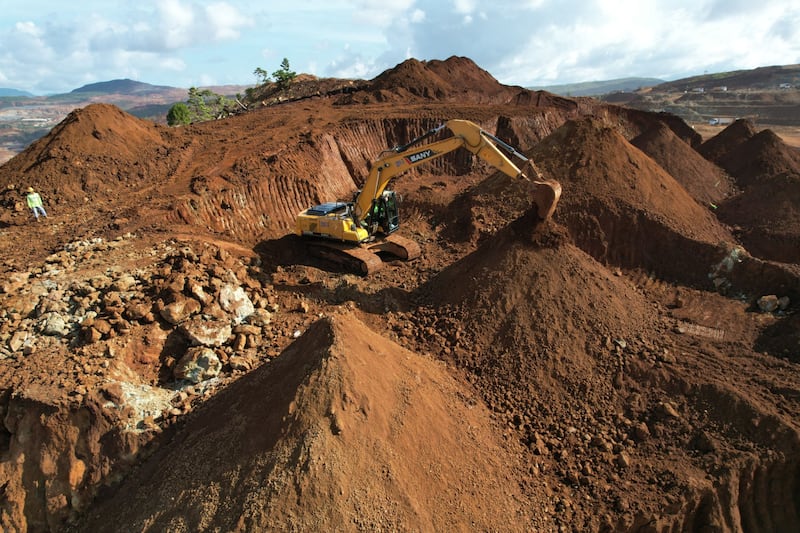One of the persistent debates surrounding the change from combustion cars to electric cars is that of the environmental sustainability of batteries. A commonly used phrase is that “mining for battery materials is worse than drilling for oil”, and, on the face of it, there seems to be some validity to the argument. Does it truly hold water, though?
First of all, what’s actually in an electric car battery? The batteries being used in electric cars use lithium-ion chemistry, the same as the batteries in our phones, tablets, laptops and countless other electronic devices.
This is true, at the basic level of chemistry, but the batteries in cars are designed to be far more robust, both physically and chemically, than those in your iPhone. But lithium – a rare Earth metal, the supply of which is often tight – is not the most-used material in your car’s battery.
[ What happens when your EV battery finally runs out of power?Opens in new window ]
In fact, the greater part of your battery is made up of graphite, the same stuff that makes up the “lead” in a common pencil. Graphite is cheap and plentiful, and mining for it isn’t especially nasty, although obviously the mining machinery that’s used has its own carbon impact and there are dust pollution issues with graphite mines. About 53 per cent of your battery, by weight, will be graphite and it’s the material that holds the charged-up ions of lithium when the battery is fully charged – making it the anode part of the anode-cathode construction of a battery.
Speaking of construction, your car’s battery is actually made up of lots and lots of individual battery cells. These can be cylindrical in shape – these little cylinders look quite like conventional AA batteries – or they can be pouch-shaped, or even look like chunky VHS video cassettes. Much of these structures will be made of aluminium – about 18 per cent of the battery by weight. Aluminium is great in one sense, in that it can be endlessly recycled and much aluminium used by industry already has been recycled at least once, but it’s true that mining for the bauxite ore from which aluminium is extracted can be messy, and the country with the world’s biggest bauxite reserves is Guinea, which has had significant human rights concerns raised over the actions of big mining companies.

Next up is nickel, and if you’re wondering why a car’s battery is expensive, this is why. Nickel is pricey – USD$18,500 per tonne at current market prices – and an average car battery uses around 29kg of the stuff. Nickel makes up the cathode – the bit of the battery to which the ions of lithium flow when you turn on the power. Mining for nickel can be a spectacularly nasty process – environmental journalist Maddie Stone has warned of some of the worst air pollution in the world being caused by nickel mining in Russia while there have been dire warnings of the dangers to human health from nickel. You can recycle it pretty easily, though so that’s something.
Copper, as you might expect, plays a big roll in an EV battery – about 10 per cent, and it’s not just for wiring. Copper plays a key role in battery anode design. While copper mining isn’t especially mucky, it is wasteful as 99 per cent of everything that’s mined goes to waste, producing just a one per cent yield of useable copper. An equal 10 per cent of your battery is steel, which is mostly used for the outer structure of the battery, and to provide impact and crash protection.
Manganese is another critical battery material – used to help stabilise the cathode, the battery’s negative terminal. Manganese is everywhere in life, indeed without trace amounts in our diets, none of us would last very long. However, too much manganese – such as might be inhaled from air pollution close to manganese mines – is horribly toxic and damaging. About five per cent of your battery, by weight, is made of the stuff.
[ A car is not magically sustainable by default of being electricOpens in new window ]
At 4 per cent of your battery by weight is cobalt, often seen as the bad boy of battery chemistry. By using it in the cathode, you make the battery more reliable and long-lived, but extracting the stuff from the ground is a fraught process Toxic dumping from cobalt mining has been responsible for devastating environmental damage, and then there’s the human cost – cobalt is most likely to be found in the Democratic Republic of Congo, a country Amnesty has accused of allowing both children and adults to work “in horrendous conditions” in Cobalt mines. Car makers have pledged to source cobalt only from mines not found to be in breach of human rights, but it’s a tricky process at best.
Lithium is the most important part of the battery, yet by weight it accounts for just 3.2 per cent of the EV battery. It’s the electrons that make up lithium’s atoms that actually store the charged electrical energy, though. Without that tiny 3.2 per cent, a battery is merely an assembly of parts. Lithium itself isn’t harmful – you’ll find lots in potatoes and tomatoes – but it takes a colossal amount of water to extract it, as much as 500,000 litres per tonne of lithium. There are also serious emerging geopolitical issues over the sourcing of lithium.

But here’s the crucial question. Once we’ve mined all that material, processed it, and run it through a factory to make an actual battery, have we committed a greater environmental crime than drilling, refining, and burning oil?
The answer is: almost certainly not. There are a lot of ifs and buts, and clearly the mining industry around the world is going to be coming under ever greater scrutiny to clean up its act, both ecologically and politically. It is also true that, currently, electric cars produce more CO2 emissions while they’re being built than cars with petrol or diesel engines, which means that you theoretically have to keep running an EV longer to put it “in credit” against the emissions of a petrol car. EVs are also typically much heavier than a combustion engine car, which causes its own issues with efficiency and with emissions from tyres and brakes. Then there are the question marks over the carbon-efficiency of national electricity grids and supply.
According to research, the lifetime emissions for a fuel-powered car are just over twice that for an EV (including end-of-life recycling)
Nonetheless, the official word is that EVs are still, overall, cleaner. According to the US Environmental Protection Agency: “Some studies have shown that making a typical EV can create more carbon pollution than making a gasoline car. This is because of the additional energy required to manufacture an EV’s battery. Still, over the lifetime of the vehicle, total Green House Gas (GHG) emissions associated with manufacturing, charging, and driving an EV are typically lower than the total GHGs associated with a gasoline car. That’s because EVs have zero tailpipe emissions and are typically responsible for significantly fewer GHGs during operation.”
According to research by the Argonne National Laboratory, the comparison is actually pretty stark. The lifetime emissions for a fuel-powered car are just over twice that for an EV (including end-of-life recycling) and 74 per cent of those come simply from burning fuel. The EV’s “in-service” emissions, by contrast (and taking an average mix of electricity supply) are almost zero. The battery, in the context of full-life emissions, actually only accounts for 18 per cent of the total emissions.
There’s another layer to that, though. Once you’ve built a battery, it can be reused. Once their power capacity has fallen below that useful for an electric car, an EV’s batteries can be reused whole as static batteries for storage, whether that be for industrial use, or even to provide “buffer” power for high-speed electric car chargers. Once they’ve been used for that, there is almost nothing from a battery that cannot be recycled and used again for a new, fresh battery. Indeed, all of the world’s car makers are currently gearing up for an expected large influx of second-life batteries to be recycled and reused in the coming years.
By contrast, once you’ve dug up some oil, refined it into petrol, and burned it in an engine, its useful life is gone, lasting mere seconds. But its carbon emissions hang around forever.
What’s in a battery?
Graphite 28.1%
Why’s it there? It’s a stable material for the anode, the battery’s positive terminal.
Aluminium 18.9%
Why’s it there? For the battery’s structure and for the negative terminal, the cathode.
Nickel 15.7%
Why’s it there? It makes up part of the cathode.
Copper 10.8%
Why’s it there? It’s part of the anode, as well as making up the wiring.
Steel 10.8%
Why’s it there? Protection panels to prevent the battery being split open in a crash.
Manganese 5.4%
Why’s it there? Stabilising material for the cathode.
Cobalt 4.3%
Why’s it there? Stabilising material for the anode.
Lithium 3.2%
Why’s it there? It’s the electrons in the lithium atoms that actually store the battery’s electric charge.
Iron 2.7%
Why’s it there? It forms part of the structure of the cathode.





















